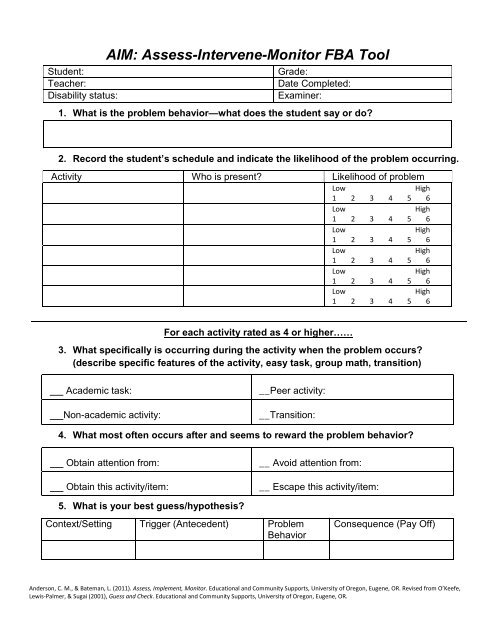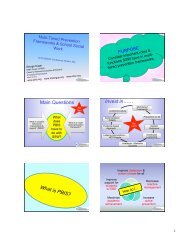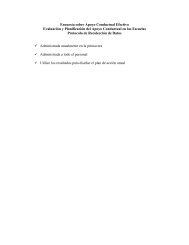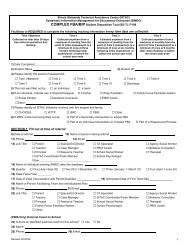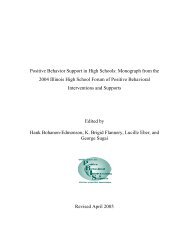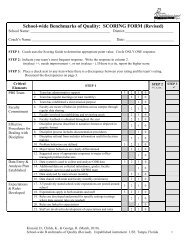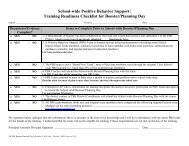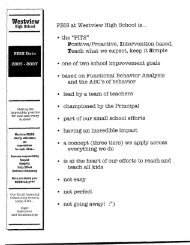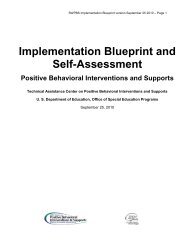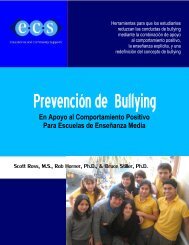AIM: Assess-Intervene-Monitor FBA Tool - PBIS
AIM: Assess-Intervene-Monitor FBA Tool - PBIS
AIM: Assess-Intervene-Monitor FBA Tool - PBIS
You also want an ePaper? Increase the reach of your titles
YUMPU automatically turns print PDFs into web optimized ePapers that Google loves.
<strong>AIM</strong>: <strong>Assess</strong>-<strong>Intervene</strong>-<strong>Monitor</strong> <strong>FBA</strong> <strong>Tool</strong><br />
Student:<br />
Grade:<br />
Teacher:<br />
Date Completed:<br />
Disability status:<br />
Examiner:<br />
1. What is the problem behavior—what does the student say or do?<br />
2. Record the student’s schedule and indicate the likelihood of the problem occurring.<br />
Activity Who is present? Likelihood of problem<br />
Low<br />
High<br />
1 2 3 4 5 6<br />
Low<br />
High<br />
1 2 3 4 5 6<br />
Low<br />
High<br />
1 2 3 4 5 6<br />
Low<br />
High<br />
1 2 3 4 5 6<br />
Low<br />
High<br />
1 2 3 4 5 6<br />
Low<br />
High<br />
1 2 3 4 5 6<br />
For each activity rated as 4 or higher……<br />
3. What specifically is occurring during the activity when the problem occurs?<br />
(describe specific features of the activity, easy task, group math, transition)<br />
Academic task:<br />
Non-academic activity:<br />
__Peer activity:<br />
__Transition:<br />
4. What most often occurs after and seems to reward the problem behavior?<br />
Obtain attention from:<br />
Obtain this activity/item:<br />
__ Avoid attention from:<br />
__ Escape this activity/item:<br />
5. What is your best guess/hypothesis?<br />
Context/Setting Trigger (Antecedent) Problem<br />
Behavior<br />
Consequence (Pay Off)<br />
Anderson, C. M., & Bateman, L. (2011). <strong>Assess</strong>, Implement, <strong>Monitor</strong>. Educational and Community Supports, University of Oregon, Eugene, OR. Revised from O’Keefe,<br />
Lewis-Palmer, & Sugai (2001), Guess and Check. Educational and Community Supports, University of Oregon, Eugene, OR.
<strong>AIM</strong>: Develop an Intervention<br />
Context/Setting Trigger (Antecedent) Problem<br />
Behavior<br />
Consequence (Pay Off)<br />
Provide frequent attention<br />
throughout the activity<br />
Build an intervention (circle strategies you choose)…<br />
1. What can be done to prevent the problem from occurring?<br />
Change class seating<br />
arrangement or location of<br />
student’s seat<br />
Provide choices such as what<br />
to do first or what tools to use<br />
Modify amount or type of<br />
activity<br />
Provide extra help/checks for<br />
understanding<br />
Provide an opportunity to<br />
engage in a preferred activity<br />
first (neutralizing routine)<br />
Increase home/school<br />
communication<br />
Check to see if student has<br />
needed materials and if not,<br />
provide them before they are<br />
needed<br />
Modify student’s schedule<br />
2. What skills can be taught?<br />
Asking for help Self-management skills Problem solving skills<br />
Asking for a break Asking for attention Teach peers to ignore<br />
problem behavior<br />
Asking for an alternate<br />
activity/assignment<br />
Specific academic skills<br />
3. How can the payoff for the problem behavior be minimized?<br />
Provide consistent and calm<br />
response<br />
Provide verbal praise to students<br />
who are meeting expectations<br />
Prompt peers to ignore<br />
problem behavior<br />
No eye contact or other<br />
response<br />
Prompt student to return to desired<br />
activity (verbal prompts, your<br />
Provide verbal<br />
reprimand<br />
Offer assistance with task or<br />
activity<br />
proximity, modeling, etc)<br />
Provide tangible reward to students<br />
meeting expectations<br />
4. What incentives can be provided for the desired behavior?<br />
Provide extra attention to the student Allow student to be the helper<br />
Provide negative<br />
consequence (i.e., timeout,<br />
loss of preferred<br />
activity)<br />
Provide student with a break<br />
Provide choice of task or preferred activity<br />
Allow student to pick activity for group or class<br />
Provide opportunity for peer interaction<br />
Anderson, C. M., & Bateman, L. (2011). <strong>Assess</strong>, Implement, <strong>Monitor</strong>. Educational and Community Supports, University of Oregon, Eugene, OR. Revised from O’Keefe,<br />
Lewis-Palmer, & Sugai (2001), Guess and Check. Educational and Community Supports, University of Oregon, Eugene, OR.
<strong>AIM</strong>: How Will the Intervention be Implemented?<br />
a. What will be done to prevent the problem from occurring?<br />
Who is involved? What will occur? When will it occur? Where will it occur?<br />
b. What skills will be taught?<br />
Who is involved? What will occur? When will it occur? Where will it occur?<br />
c. How can the payoff for the problem behavior be minimized?<br />
Who is involved? What will occur? When will it occur? Where will it occur?<br />
d. What incentives can be provided for the desired behavior?<br />
Who is involved? What will occur? When will it occur? Where will it occur?<br />
<strong>AIM</strong>: Is the Intervention Effective?<br />
***record the date below each day’s label. Circle a rating—4 is a great day and 1 is a bad day***<br />
Day 1 Day 2 Day 3 Day 4 Day 5 Day 6 Day 7 Day 8 Day 9 Day 10<br />
4 3 2 1 4 3 2 1 4 3 2 1 4 3 2 1 4 3 2 1 4 3 2 1 4 3 2 1 4 3 2 1 4 3 2 1 4 3 2 1<br />
Anderson, C. M., & Bateman, L. (2011). <strong>Assess</strong>, Implement, <strong>Monitor</strong>. Educational and Community Supports, University of Oregon, Eugene, OR. Revised from O’Keefe,<br />
Lewis-Palmer, & Sugai (2001), Guess and Check. Educational and Community Supports, University of Oregon, Eugene, OR.


